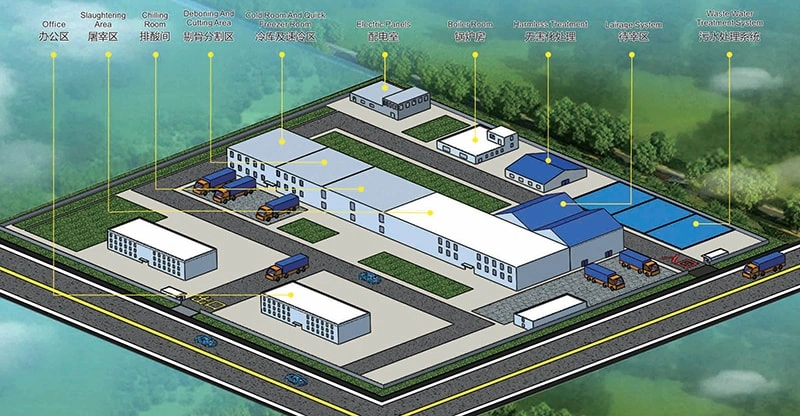Slaughterhouse areas should be divided into production zones and living zones. Within the production zone, a clear distinction should be made between non-clean areas and clean areas. In regions with severe cold, cold, or hot summers and cold winters, non-clean areas should not be located on the upwind side of the main summer wind direction of the plant, and clean areas should not be located on the downwind side of the main summer wind direction of the plant.

In regions with hot summers and warm winters, as well as temperate regions, non-clean areas should not be located on the upwind side of the plant's predominant wind direction throughout the year, and clean areas should not be located on the downwind side of the plant's predominant wind direction throughout the year.
In regions with severe cold, cold, and hot summer-cold winter climates, summer temperatures are relatively high and odor pollution is more serious than in winter, so the influence of the prevailing summer wind direction is primarily considered; in hot summer-warm winter and mild regions, winter temperatures are also relatively high, so the influence of the prevailing wind direction throughout the year should be considered. Sometimes, due to landform limitations or when the winter and summer wind directions are exactly opposite, the arrangement of non-clean areas and clean areas can be perpendicular to the prevailing summer or yearly wind direction.
The overall site plan of the slaughterhouse should be clearly defined. The non-clean areas of the production zone include: the non-clean and semi-clean sections of the slaughterhouse, pre-slaughter facilities, sewage treatment station, boiler room, harmless disposal facilities, and waste collection sites. The clean areas of the production zone include: the clean section of the slaughterhouse, cutting workshop, cooling room, freezing room, temporary storage for finished products, shipping area, cold storage, and other auxiliary facilities.
The entrance for live animal, the exit for waste, and the exit for products in the production area should be set up separately. The transportation channels for live animals, waste, and products must not be shared. The flow of people and goods in the clean area should not intersect with that in the non-clean area, and entrances and exits should not be shared, to prevent contamination of processed products. If waste is transported using sealed vehicles, its transportation channel and exit may be shared with the live animal channel and entrance.
The layout of the slaughtering and cutting workshops in the plant, as well as the production auxiliary rooms and facilities, should meet the requirements of the production process and food hygiene, and must not allow the products to be contaminated.